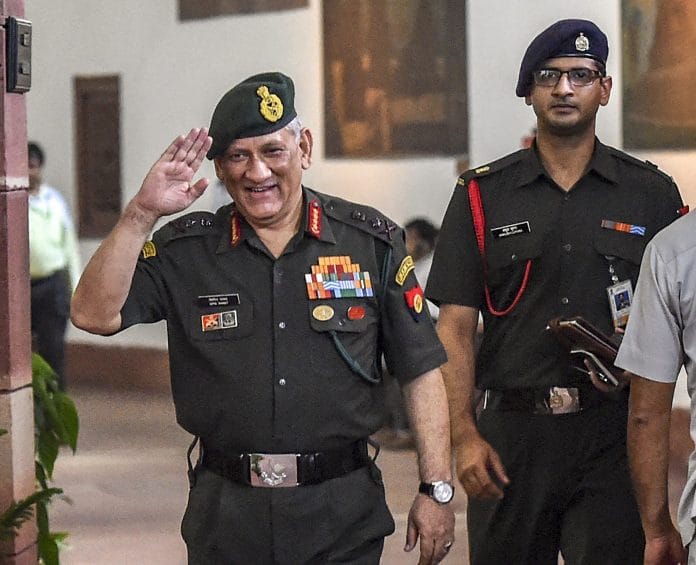The Indian Army HQ claimed in a paper that the reforms proposed by Indian Army chief General Bipin Rawat would usher in a ‘revolution in military affairs’.
New Delhi: Indian Army chief General Bipin Rawat’s proposals for radical reforms that restructure the soldiery are facing opposition from within the force, sources at the Army headquarters have told ThePrint.
At least two of seven Indian Army commanders have “expressed reservations” on cadre and force restructuring that aim to bring down manpower and eliminate structures such as a division in peace stations.
An Army commanders’ conference that began here Tuesday will be discussing the issues. General Rawat has scheduled Sunday, 14 October, the concluding day of the meeting, to brainstorm four studies on the reforms.
Also read: Indian Army reforms: Cutting administrative flab or needless downsizing?
“As part of the conclave, commanders and directorates at the Army headquarters will in a collegiate deliberate on important studies that have been ordered to meet future challenges,” said an official statement from the Army.
“There are four studies examining operational and optimisational issues of the Army and the headquarters as also human resources management aspects,” said the official statement.
“We are in the middle of a churn,” said one officer involved in the studies, “There is an academic debate that is on. It is okay to differ so long as you don’t throw a spanner in the works.”
Equivalent in rank to the vice-chief, Army commanders have full authority over their areas of responsibility. Any reform proposal, or any command from the headquarters, must have their full participation to be executed.
The seven Army commanders now are Lt General Manoj Mukund Naravane (East), Lt General Ranbir Singh (North), Lt General Surinder Singh (West), Lt General Cherish Mathson (South West), Lt General Satinder Kumar Saini (South), Lt General Pattacheruvanda C. Thimayya (Army Training Command) and Lt General Abhay Krishna (Central). The vice-chief is Lt General Devraj Anbu.
‘Less tail, more teeth’
In August, the Army headquarters circulated papers summarising the proposed reforms, saying they aimed to cut the ‘teeth-to-tail ratio’. In the statement on the conference, it added that the studies to be discussed “aim to improve the teeth-to-tail ratio, with the purpose of strengthening the structures within the Army to make it combat ready for the future”.
The teeth-to-tail ratio is the number of support personnel required to sustain units of combat soldiers. The lower the number of support personnel — the “tail” — the more the resources available to make the combat soldiers – the “teeth” – more efficient.
The Army headquarters claimed in a paper that the proposed reforms, which included an effort to restructure the cadre for the first time in 35 years, would usher in a “revolution in Indian military affairs”.
Among the most debated issues within the force that is also expected to dominate discussions at the commanders’ conference is the proposal to eliminate divisions and create “integrated brigades” or battle groups that report directly to corps headquarters.
A corps is the largest field formation in the Indian Army. Usually, a corps has about three divisions, a division has three brigades, and a brigade has three battalions. The numbers vary depending on the operational area.
Also read: Indian Army chief wants to revolutionise the military — by cutting manpower
Currently, a corps is commanded by a Lt General, a division by a Major General, a brigade by a Brigadier. This hierarchy could change if the proposal for integrated battle groups (IBG) is implemented. An IBG would be headed by a Major General, according to one proposal. This could make the rank of Brigadier redundant. Each IBG would have four to five battalions.
The Army commanders’ conference is held twice a year. The October conference also includes promotion boards that select officers for the senior ranks of Brigadier, Major General and Lt General.







I guess no other work for army chiefs and other chiefs…. Started polluting even defence….. If sudden war and shortage comes then….they will be knowing the value of… People these thoughts wont be helpful in any way whih are coming if the defence sector is clean …. Hearted and why don’t the aged chiefs.. take retirement and give chance to new cadre… They might come with some innovative thoughts.. which will be helpful for our country
They can claim what ever they want but that is not going to change the fact that the people who preceded the current Chief were not fools. They were of same mettle as Gen Rawat think he is made of. So the strength was developed for a two front war with Pakistan and China. What will happen if he (Gen Rawat) in his exuberance cuts the Army strength and we have a war tommorow with our friendly Neighbourhood tommorow. As such we are having a Meager Defence budget as compared to our adversaries and also we want a world power tag. Then we say strength of Army is too much and Defence budget is eaten up by the strength in Payment of dues to Soldiers. What about Ministry of Defence strength (The Civilian Strength working). It is galactic as compared to size of troops they serve. Moreover they serve their awn agenda. What about Massive MESS organisation of Civilians who are also paid out of defence budget. They are almost double the strength of the Army strength. We should first try and apply economics to these people and they proceed to a structure (Army) which has grown after a lot of trial and error, and not merely sit in cushy offices and start forming imaginary theories.